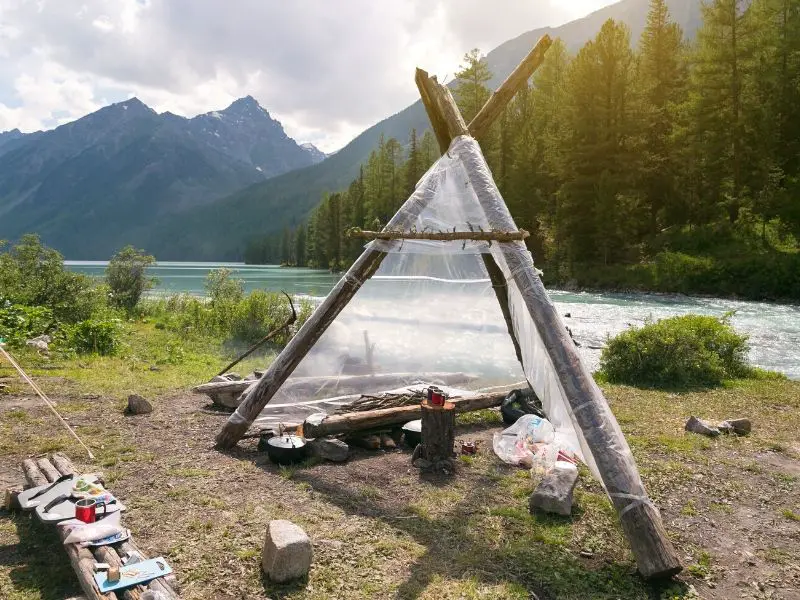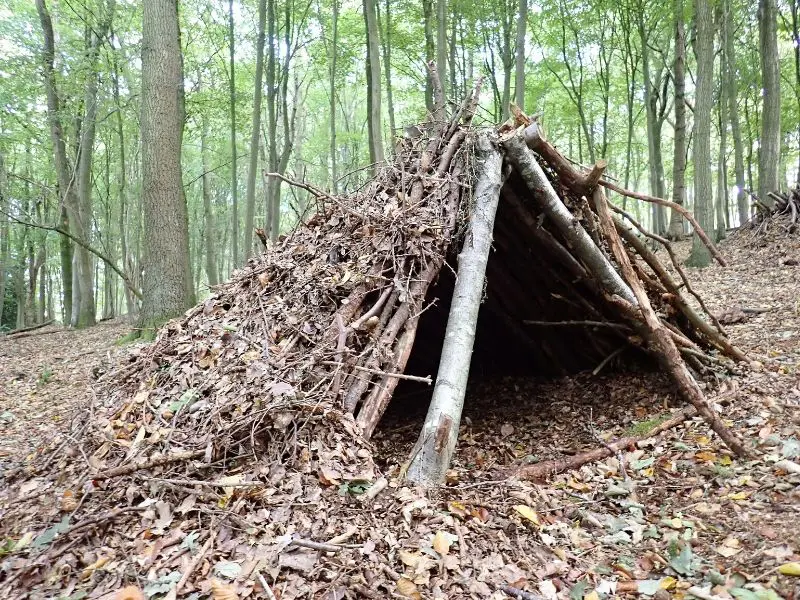SHTFPreparedness may collect a share of sales or other compensation from the links on this page.
Whether you’re heading on a low-cost camping trip or you get stranded out in the wilderness without many supplies, knowing how to build an emergency wilderness shelter is incredibly important.

Types of Emergency Wilderness Shelter
A temporary emergency wilderness shelter can get you through the night no matter where you are.
Depending on where you are in the wilderness, there are many different ways to build a shelter. However, the types of emergency wilderness shelters tend to break down into two categories:
- poncho shelters
- natural shelters
If you have a poncho Mylar survival blanket or some other kind of waterproof material, you can make a poncho shelter.
One of these should be included in every bug-out bag. If you don’t have any of those things, you’re going to need to make a natural shelter.
Poncho Shelters
USGI Industries Military Poncho Emergency Tent Shelter Ripstop SilNylon Poncho and Emergency Shelter –
Ripstop SilNylon Poncho and Emergency Shelter – 
Lean-To Poncho Shelter
There are a few different kinds of poncho shelters.
The most basic kind of poncho shelter is a lean-to. A lean-to is a shelter made with two points of contact. You will need to stretch your poncho tight. Attach it to the ground and then lean it at a 45-degree to a fixed structure.
If you are in the desert or other dry areas, you might be able to find a rock outcropping or a short tree. You can then attach the top of the poncho to the tree at a 45-degree angle. When you do this, make sure that the structure is very stable.
Also, take a few minutes to figure out which way the wind blows. You want the lean-to facing into the wind. That will keep wind, rain, and sand from blowing into your shelter.
If you cannot find a sufficient rock wall or sufficiently large tree, you can build the lean-to by creating the second point of contact. If two trees are close together, you can string a rope between them. Tie the top of the poncho to the rope and affix it to the ground. Just that quickly, you have a quality lean-to.
How to Stay Warm in Your Poncho Shelter
If you are in a dry area, you might be surprised by how quickly the temperature can drop when the sun goes down.
To maintain a comfortable temperature in your lean-to, you can build a fire outside of your lean-to. Since you need to keep the fire away from the poncho and not so close that you inhale smoke, a lot of heat will be lost.
To reduce the loss of heat, you can construct a firewall. A firewall is any type of structure that is on the opposite side of the fire from your shelter. That will cause light and heat to bounce towards your shelter.
In a sandy environment, you can actually just build a sand or earth embankment.
If you have wood available, a wall can be built by driving two sticks into the ground vertically and tying other branches to them. Paracord is probably the easiest way to tie items together; it is truly an indispensable survival tool.
Poncho Tent
The other type of poncho or Mylar blanket shelter is a poncho tent. Whereas a poncho lean-to has two points of contact, a poncho tent has three points of contact.
To build the poncho tent, string a rope between two trees or rock outcroppings. Make sure you pull the rope taut. Then, drape the poncho or Mylar blanket over the rope. Secure it to the ground on both sides to form an A-shaped tent.
This type of shelter requires a larger poncho than a lean-to but it will protect you from wind and rain more completely. It will also keep you a little bit warmer.
Building a fire outside of the tent and supporting it with a firewall will keep you warm throughout the night.
Natural Shelters

In contrast to poncho shelters that require ponchos and ropes, a natural shelter can be made with things found in the wilderness. The types of earthen shelters are actually similar to the poncho shelters but made from different resources.
A lean-to is still the simplest type of shelter. If you are anywhere that you can find branches, you will be able to build a quick lean-to. If the weather has been dry for a while, you might even be able to gather branches off the ground. Otherwise, you’ll need to cut green branches off of a tree.
To cut branches off a tree, you can use an axe, hatchet, or saw. If you’re cutting small branches or if you’re walking far, you want a hatchet. They’re easier to carry.
An axe is going to be much heavier and longer, which means you’ll be able to cut larger branches. You can see a more in-depth comparison of axes and hatchets here.
How to Build Your Natural Lean-To Shelter
To find the right branches for your lean-to, you need two long branches that are about the same length. These will form the roof of the lean-to. Then, decide how wide you need your lean-to. It should probably be at least wide enough for you to lay down completely.
Then, use your axe or hatchet to cut down several branches long enough to make a roof. If you can find large elephant ear leaves, palm fronds, or similarly large leaves, you will be able to make a roof out of these. A vine of some sort is a great substitute for rope or twine. If you can’t find vines, you can use an axe or knife to cut thin strips of green wood; while they’re still green, they can be used to tie branches to your lean-to.
A natural tent is made by essentially building two sides to a lean-to and leaning them against each other.
Underground Shelters
The final kind of natural shelter is actually an underground shelter. Underground shelters can be thirty or forty degrees Fahrenheit cooler than the outside air. However, the earth holds heat much better than the air. That makes them the perfect natural shelter for deserts.
To build the underground shelter, find a depression between rocks or dunes. If you can’t find a rock or dune, dig at least deep and wide enough that you can lie down comfortably. Pile up all of the dirt or rocks that you remove from the trench.
Finally, you need to create a partial roof over the top of your trench. If you have leaves or branches, you can use sand or rocks to anchor the branches as a roof.
Related: check out this guide to underground bunkers.
If you have a poncho, it won’t be a completely natural shelter, but it will be the easiest way to create a partial roof for your underground shelter.
Conclusion
These four kinds of shelters, two natural and two poncho, can keep you warm and dry no matter where you find yourself.
Learn how to create an emergency wilderness shelter for practice, before you actually needed it. If you are stranded in the wilderness or just testing your wilderness survival skills, keep these shelters in mind.


